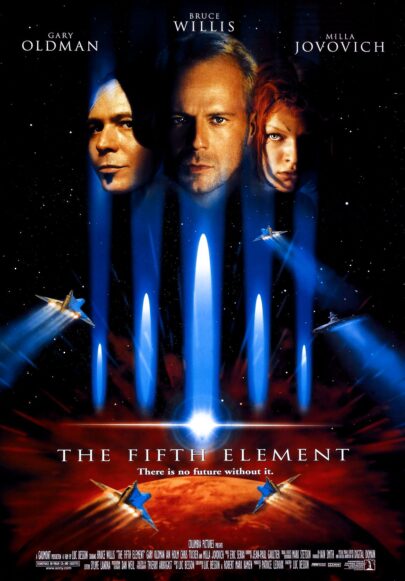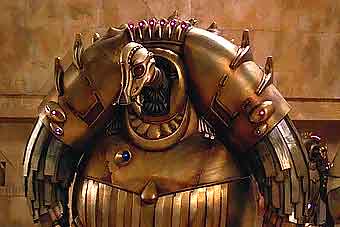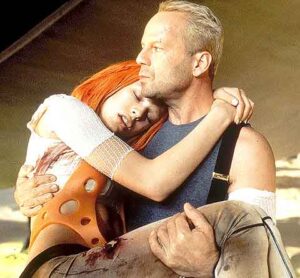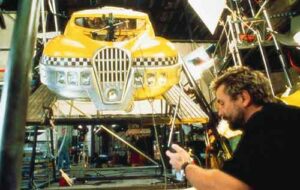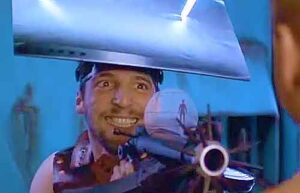Arguably the purest distillation that exists of French director Luc Besson’s strengths and weaknesses, a 1997 science fiction fever dream with stunning visuals and a horrendously conceived narrative. Scripted by Besson and THE KARATE KID’s Robert Mark Kamen (who co-wrote quite a few subsequent Besson productions, including the mega-successful TAKEN), THE FIFTH ELEMENT was apparently a dream project for Besson, who claims to have conceived it as a teenager.
The film, which managed to secure the participation of Bruce Willis, Besson’s LEON (1994) co-star Gary Oldman and the late Luke Perry, quite blatantly displays its influences, particularly the comics of Jean-Claude Mézières (whose VALERIAN AND LAURELINE comic series was adapted for film by Besson in 2017) and Jean “Moebius” Giraud, both of whom ended up doing design work for THE FIFTH ELEMENT (Alejandro Jodorowsky, who scripted the Moebius illustrated Euro comic saga THE INCAL, inserted himself into the mix by unsuccessfully suing Besson for plagiarism). The end result was a surprise hit that for over a decade held the title of Most Successful French Film of All Time.
The film’s early moments directly ape those of Bessons’ previous three features, which all began with a tracking shot along a flat surface that slowly tilted upwards—with the “surface” here being an asteroid field in outer space. Cut to Egypt in 1914, where a renowned professor (John Bluthal) and his assistant (Luke Perry) are present at an ancient temple for the arrival of an alien spaceship. The ship’s inhabitants, known as Mondoshawans, snatch up elaborately carved stones representing the four elements, and a sarcophagus representing a fifth, as these precious artifacts are apparently “not safe on Earth anymore.” Before blasting off the aliens warn of the coming arrival of “the Evil,” which is set to occur in 300 years.
Cut to the 23rd Century and the Evil’s prophesized appearance, in the form of a massive fireball headed for Earth. The Mondoshawans turn back up with (it seems) the five elements, which when combined can create a weapon capable of the destroying the fireball, but their spaceship gets blown up by agents of Jean-Baptiste Emanuel Zorg (Gary Oldman), a scumbag businessman in league with the Evil.
Korben Dallas, the Bruce Willis incarnated hero, doesn’t turn up until 16 minutes into the film (and then is frequently overshadowed by subsidiary characters). He’s a taxi driver residing in South Brooklyn, where cars fly and most everyone speaks in French accents. He’s thrust into the action when Leeloo (Milla Jovovich), the incarnation of the Fifth Element, falls into his cab—she having been reconstituted from a severed hand filched from the wrecked Mondoshawan spaceship and clad in an artfully contrived wraparound bandage, but has escaped from her human captors.
Following a breakneck flying car chase through the skies of New York, Korben teams up with Vito Cornelius (Ian Holm), a priest, and becomes ensnared in a plot to retrieve the four stones, which have somehow ended up in the care of an extraterrestrial opera diva (Maïwenn Le Besco). This involves a sham radio contest that sends Korben on an interstellar vacation to a floating opera house, together with Vito and members of Zorg’s crew, who’ve all stowed away aboard Korben’s spaceship.
Luc Besson is one of the great visual magicians of the movies, and that aspect kept me going through THE FIFTH ELEMENT’s vastly overcomplicated and undisciplined excuse for a story. he visual design, courtesy of cinematographer Thierry Arbogast, production designer Dan Weil, costume designer Jean-Paul Gaultier and the aforementioned conceptual work of Jean-Claude Mézières and Jean Giraud, is stunning, superbly replicating the imagery of the Euro comics that inspired Besson, with consistently inventive camerawork operated by Besson himself.
The scantily clad Milla Jovovich, in her breakthrough role, is certainly among the most striking sights on display (Besson was evidently just as taken with her as I, as the two were married in December 1997). She and the testosterone-addled Bruce Willis provide a strong two-tiered anchor, but Besson dwells interminably on Chris Tucker as an obnoxious TV host (in a performance patterned, reportedly, on Michael Jackson and Prince). Over-attention to supporting players is a recurring complaint, with an early bit involving Willis confronting a would-be robber eating up a puzzling amount of screen time, presumably because the robber was played by the prominent French actor/filmmaker Matthieu Kassovitz; likewise Luke Perry in the opening scene, whose outsized presence only distracts from the narrative points being made.
Another problem is with the tone, which, as was pretty standard in the late nineties, places everything on a sniggeringly comedic (read: Tarantino-esque) level. This is problematic because, although Besson has always been more light-hearted in temperament than most of his French cinema colleagues, he simply isn’t very funny.
Vital Statistics
THE FIFTH ELEMENT (Le Cinquième Élément)
Columbia Pictures/Gaumont
Director: Luc Besson
Producers: Patrice Ledoux
Screenplay: Luc Besson, Robert Mark Kamen
Cinematography: Thierry Arbogast
Editing: Sylvie Landra
Cast: Bruce Willis, Gary Oldman, Ian Holm, Mila Jovovich, Chris Tucker, Luke Perry, Brion James, Tom Lister Jr., Lee Evans, Charlie Creed Miles, Tricky, John Neville, John Bluthal, Mathieu Kassovitz, Christopher Fairbank, Kim Chan, Richard Leaf, Julie T. Wallace, Al Matthews, Maïwenn Le Besco

